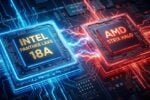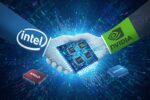הראיון באנגלית
Q. Can you introduce who will be answering these questions?
[Baker, Richard] Richard Baker – N. European Marketing Manager
Q: With the recent resurgance of Pentium 4-class machines, we are finally beginning to see a competitive solution from Intel.
Website have indicated that in order to nullify Intel\'s clock-speed marketing advantage, AMD intends to introduce a new naming scheme for their processors, similar to the naming scheme once utilized by the now-late Cyrix with their MP serious of processors.
Is this correct, and if so would you care to elaborate?
[Baker, Richard] Sorry, but I can\'t talk about unannounced products
Q: Now that the AthlonMP-class processors are finally on the market, what does AMD intend to do to push the updated Athlon core ("Palomino") over the existing "Thunderbird" core?
Seeing that Intel has just introduced a 2GHz Pentium 4 (giving them the afforementioned clock speed advantage), what kind of clock speeds should we expect to see coming from AMD this year?
[Baker, Richard] The Palomino core is the intended replacement for the Thunderbird core. Again, I can\'t speculate as to what speed grades we will be launching in the future.
Q: The Athlon "Thunderbird" core turned out to be able to extend to ridiculously high clock speeds. How far do you expect the "Palomino" core to go, assuming you meet your yield margins?
[Baker, Richard] At least 2 gig.
Q: Perhaps the single greatest shortcoming of the Athlon architecture so far has been the lack of mutliprocessor-capable platforms.
Now, after over two years, we are finally starting to see MP platforms in the shape of Tyan\'s Tiger/Thunder boards. However, the cost of the cheaper of these motherboards is still expected to be over $250, quite a bit more expensive than a comparable MP platform for the Pentium 3 processor.
While the market for MP platforms seems to extend beyond the need of a minority of professionals, the prices for Athlon-based MP platforms currently does not meet the price criteria for consumer-level MP systems.
Does AMD intend to rectify the situation, and how?
[Baker, Richard] The cost of Athlon MP systems are comparible with similar PIII sytems and massively cheaper than dual P4 systems, and after all, Athlon is compared to P4 not PIII. As far as consumer MP systems go, then this really has not been possible up until now because they would have to use Windows 2000/NT4 – not really a consumer-friendly operating system.
With the release of the professional version Windows XP then I think we might just start to see a very few consumer MP systems. Having said that, there are not many consumer applications that can take advantage of a second processor. Quake and Photshop spring to mind, but I can\'t think of many more.
Q. Are you working along with software companies to ensure more widely support for the 3DNow! technology? Do you have any plans to expand these set of commands, and make a "new version" of 3DNow! that will compete with Intel\'s SSE2 ?
[Baker, Richard] 3DNow! Professional which is in the Athlon MP does have the SSE instruction set in.
Q: AMD products are not very well established in certain countries (like Israel), and unlike the plethora of Intel-oriented retailers, there is only a handful of retailers that sell AMD-based systems in such countries.
Does AMD have any plans to increase the induction of the AMD-based platforms into the local commercial market? Or, for example, to introduce branded systems (like Packard Bell or Compaq) based off of AMD processors, thereby increasing sales and market awareness?
[Baker, Richard] I\'m sorry, but I\'mnot very familiar with the Israeli market, however, I do know that we are looking strongly at markets which we have not had a large market share with a view to working harder there.
Q: The price differential for AMD products between countries is extremely high.
For example, while it is quite possible to purchase a top-of-the-line Athlon 1.4 GHz processor for a "street price" of around $100, whereas in Israel the same processor costs around $175. Given the size of the product, I believe we can discount the shipping costs as a valid explanation for the price differential.
How do you explain this difference in pricing, and what will AMD do to reduce it?
[Baker, Richard] AMD has a global pricing policy, which means it you buy the products from us, (as opposed from a distributor, or sub distributor) you will get the same price (for a given volume) no matter where in the world you are.
What you are seeing are price fluctuations for two reasons. Firstly different dealers have different profit expectation, and secondly, grey market activity.
Q: It has recently become known that AMD is terminating production of older processors, like the 486-compatibles and the K6 family.
Is the decision a result of an intent to clear facilities in order to increase production of more modern processors, or a simple termination of obsolete processor lines?
[Baker, Richard] Termination of old production lines. However, these products are still being shipped until the end of 2003 for our customers.
Q. A while ago, AMD introduced the HyperTransfer technology which suppose to replace the old PCI. We\'ve also heard about Intel\'s 3GIO, a competitor of yours HyperTransfer.
Can you explain a little more about the differences between these 3 technologies (the old PCI, HyperTransfer, and 3GIO) ?
When do you expect the new technology to take place in everyone\'s computers, and how do you assume it will change the way we currently use computers?
[Baker, Richard] HyperTransport is currently being used in NVidia\'s new NForce chipset. The technology has been licenced (free) to over 200 companies,a large proportion of whom are not using it in PC applications (I think Cisco are to use it in there new comms products for instance).
HyperTransport is also designed to be used for inter processor links in multiprocessing applications, particularly for our upcoming 64 bit Hammer family. 3GIO is not here yet, nor will it be for quite a while.
Q. AMD\'s processors proved to have great overclocking capabilities. Are you going to continue making such an "overclockable" processors, or you prefer to stop that, and maybe lock the clock multiplier in a more sophisticated way?
What exactly are your views on overclocking?
[Baker, Richard] We don\'t design our processors so that they are easy to overclock!
If individual users want to do this, then as long as they understand that it invalidates their warrantee, then we don\'t mind. If people start selling PCs based on overclocked parts as a commercial venture,
then we get a little upset as it damages our reputation as a stable and reliable manufacturer.
Q. As we\'ve heard, AMD is going to add to a diode to a circuit breaker that will freeze or turn off the CPU rather than let it fry when it overheats. Intel already has such protection on its processors.
Considering the fact that the current processors are getting quite hot, is AMD planning on incorporating such protection for its CPU\'s anytime in the near future?
[Baker, Richard] The Palomino core has a thermal diode on. Also Athlons disappate less heat than P4s. If you are really keen take a look at how Intel now define power disappation, they have redefined a lot of parameters to hide the fact that P4s are very \'Watty\'. For instance, they now longer give figures for maximum instantious power.
Q. While the mobile Durons has already been released, we still can\'t see any mobile Thunderbird or any other "more powerful" processor.
Intel have already done that with their Pentium 3. Should we expect a mobile Athlon anytime soon? And what about mobile DDR solutions?
[Baker, Richard] There is a mobile Athlon! It\'s called the Athlon 4. Mobile DDR chipsets are coming out soon.
Q. Is AMD going to have a 64 bit CPU, and when?
Are you prepared for the battle against Intel\'s Itanium processor?
[Baker, Richard] Our 64 bit technology is called Hammer. As opposed to Intel, who are making software companies re-write all their applications for Itanium (because it has a different instruction set), our Hammer family uses the logical extension to the x86 architecture. in exactly the same way as these moves have been done before. – ie 8 to 16 bit and 16 to 32 bit.
Therefore migrating to 64 bit usin Hammer will be transparent and seamless, unlike the intel solution.
Q. When, do you estimate, that we will see a 64 bit platform as standard for the average workstation? And what will AMD\'s solution be for that platform?
[Baker, Richard] The only need for 64 bit is to get over the 4 gig address space limitation.
Therefore theonly applicatin that will need it are those that use very large databases. As I said before, if yo use Hammer this chnage over will be seamless.
Q. AMD still doesn\'t have as much production power as Intel have. What are your future plans about that?
[Baker, Richard] You are right! We currently have 2 \'megafabs\' and Intel have 6 (I think). These fabs cost in the region of 2 billion USD and take around 3 years to build. It\'s not something that you can change overnight!
Q. Would AMD consider getting into the chipset business in a more comprehensive way, and if not, why not? Intel seems to have made lots of money doing it, so why wouldn\'t AMD?
Moreover, Does AMD have a plans to make a "overall-chipset" like Nvidia\'s nForce ?
[Baker, Richard] Intel haven\'t made any mney making chipsets, pretty much all their profits come from the processor side.
We do make chipsets (the 760 MP for instance). What we tend to do is to make the first one in a family then help our partners take that technology and improve upon it.
In other words, we make sure that the base design is stable and reliable, then let the Tiawanese gus work their magic and get the features up and the price down.
Q. And last but not least, would you care telling our readers some unique special news? I\'m sure they\'ll appreciate it as much as I will…
[Baker, Richard] Megahertz, isn\'t everything, if you\'re smart then you can get an AMD based system that performs better than anyone elses and costs a lot less – you don\'t really want to give all that money to Intel so that they can spend it on crappy TV ads do you?




















